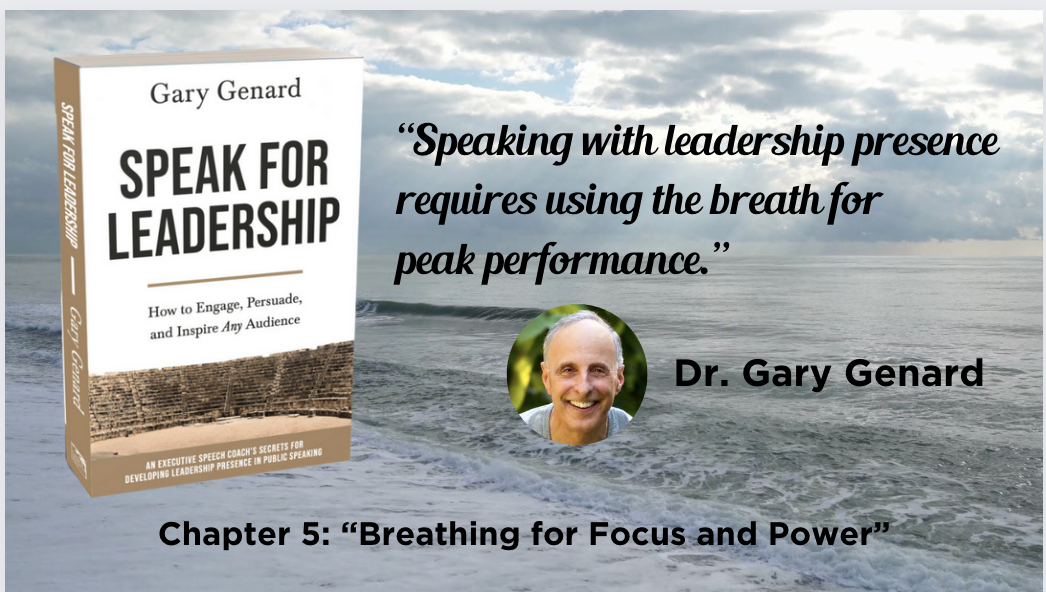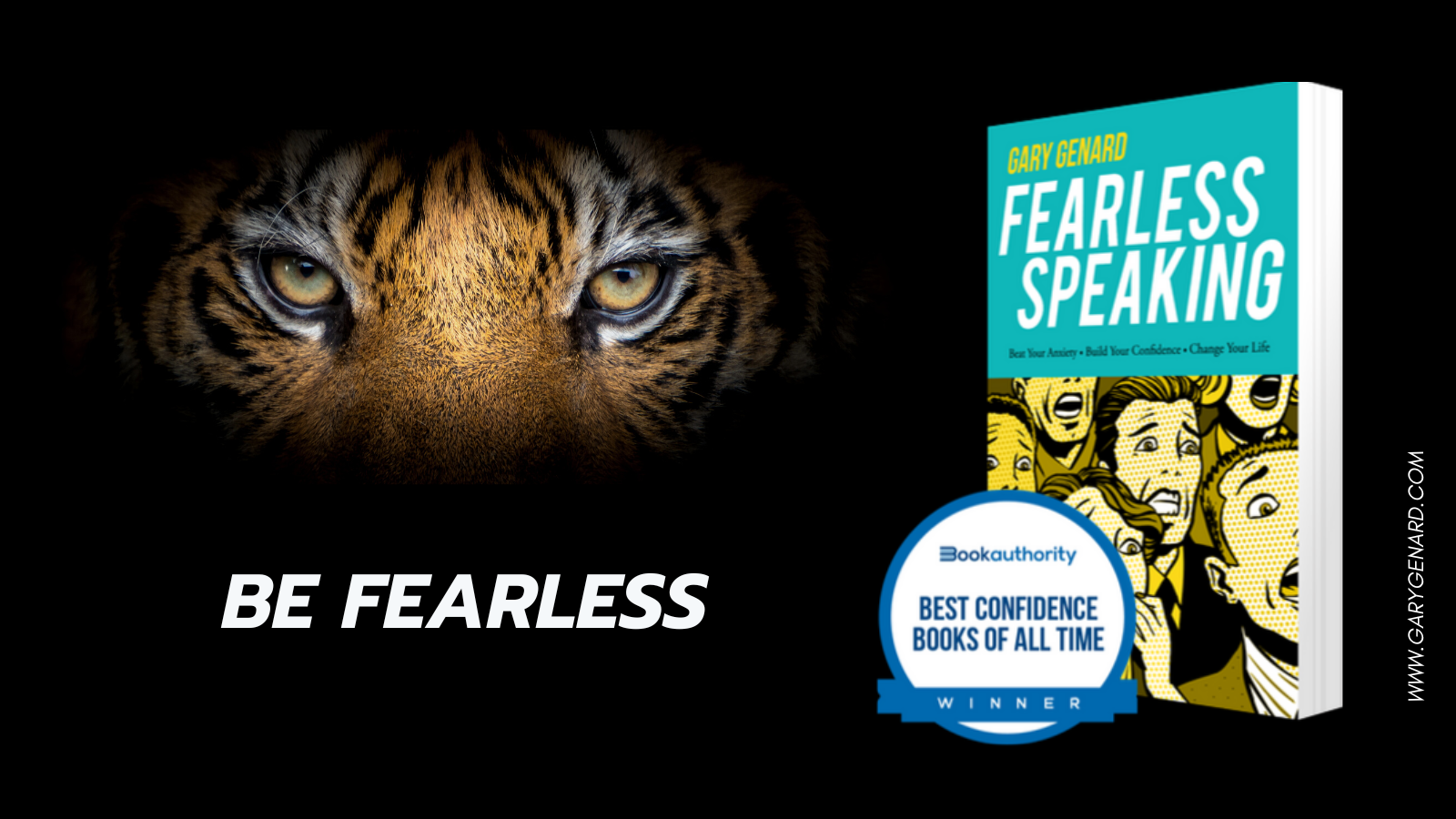Want to maximize your presence in meetings and presentations? This simple and amazing skill will boost your public speaking presence.
How good are you at exhaling? Seriously.
The exhaled breath is far more than just the expelling of stale air—it’s an essential part of the energy that makes your voice possible. The rate at which you use or expel air while speaking determines how long you can sustain that sound. Full exhalation also comes into play through the action of the vagus nerve, which slows a rapid heart rate as long as you exhale for a normal duration. Speed up your breathing, as happens when you're anxious, and that benefit vanishes.
The other key fact concerning exhalation is that it's the key to supporting the sound you’re making, i.e., having enough breath to voice your entire idea. (Try ridding yourself of all your breath and then explaining the core of your message!)
Want to be a calm yet powerful speaker? See Chapter 5, "Breathing for Focus and Power," in my book, Speak for Leadership: An Executive Speech Coach's Secrets. On Amazon.
Equally important is your emotional connection to your material; and this too depends partly on your use of breath. Your new awareness of the conscious controlled breath automatically makes you more aware and present—more mindful of this moment and place. This has unlimited value in making you more present for your listeners and able to respond to their needs (and even their challenges). When you’re connected to your own emotions as well as those of your listeners, you automatically come across as both more compassionate and more of a leader.
Using Breathing to Achieve Stage Presence
Being in the present moment is nowhere more necessary than when you’re speaking to hundreds or thousands of people. Here in particular, conscious breathing is an essential tool in your arsenal.
What I'm talking about here is mindfulness, or being fully in the "now." The more mindful you are as a speaker, the more you will perform AND respond with equal facility—the key to achieving presence as a speaker. And the secret to that level of confidence is trusting your own abilities enough to depart from your notes or slides when necessary, responding to what's actually happening in the room or cyberspace.
Breathing is also key to reducing anxiety and building confidence! Discover how in Chapter 3, "Breathing for Relaxation and Control," in my book, Fearless Speaking. On Amazon.
This need for mindfulness and presence clashes with one of the biggest challenges of the 21st century: the increasing distortion of our sense of time. Being constantly online; the mind-jarring shifts in our attention due to multitasking; ever-multiplying social media channels; the never-ending barrage of advertising and marketing messages; and our shrinking attention spans due to TV shows, commercials, and movies that substitute speed and frantic action for meaning . . . each of these phenomena change how we experience time. (Did you, in fact, become impatient with that last intentionally complex sentence?)
These continual demands on our brain and nervous system lead to what Dennis Lewis describes as “a low-grade but chronic fight or flight or freeze state, in which . . . the constant release of adrenaline and cortisol undermines our immune system and throws us into increasingly negative states of disharmony.”1
That's no way to deliver a presentation! Make sure you're on point with my Free Cheat Sheet, "10 Fast and Effective Ways to Overcome Stage Fright." Learn these quick fixes!
The danger, of course, is that this stressed-out state becomes our norm—that we consider it a necessary response to our environment. Here’s a personal story about how mindful breathing can help shield you against a stressed-out feeling of “fast-forward all the time.”
Proof of the Power of the Breath
For some years, I’ve attended an annual healthcare conference. A few years ago, while strolling through the trade show hall during a break in speakers, I decided to participate in a demonstration of a vendor’s product. This product is a band worn around the head that measures electrical brain signals. The device is meant to train users in employing biofeedback to achieve a calmer and more serene state of mind.
Want a quick exercise to counter stress? Download my Free cheat sheet, "How To Calm Your Nerves Before Speaking." This works, even if you have just 5 minutes to spare!
Here’s how the product works: while wearing the band, you listen through headphones to a sound stimulus for three minutes—the choice was a thunderstorm or ocean waves crashing. (I chose the stormy weather.) Your job as wearer of the device is to try to quiet the thunder or crashing waves you’re hearing. If your brainwaves as measured by the device reflect scattered or chaotic thinking, the sound will become louder. Conversely, if your thoughts (vis-a-vis your brain’s electrical activity) are calm, the thunder or waves will decrease in volume. By learning to use biofeedback, you’ll soon be able to become calmer and more focused.
To get through to listeners, you need to be focused. Download my Essential Cheat Sheet, "10 Ways To Stay Fully Focused When Speaking." Speak with power and presence!
There I was, then, flying through a storm (you might say). I didn’t appear to be too close to it, though, because the thunder was very faint. So, to make things more interesting, I tried to make my thoughts agitated. My reward was a barely-audible blip in the rumble from that distant storm.
When my test drive was over, the technician recorded the results. He told me my score was 93. Not knowing if that was good or horrible, I asked how most people scored. I wanted to know if I was good at biofeedback, or a pitiful specimen of humanity.
“You meditate, right?” was the technician’s answer.
“No.”
“C’mon, you meditate,” he insisted. “Nobody gets a 93 on their first try!”
I assured him that I didn’t practice meditation (though I’ve tried it from time to time). But I mentioned that I use mindful breathing on a daily basis, and have done so as a stage actor for decades. I added that I teach mindful breathing as a speech coach and trainer.
He shared with me that one of the Dalai Lama’s assistants—someone who teaches meditation—scored a 95 on the device. I wondered, however, if he was just flattering me to make a sale. So, later that day, I asked a friend I’ve known for years who was also attending the conference if he had tried the device. “Sure,” he said. “Let’s see . . . I think I scored somewhere in the 40s.”
That’s when I realized just how much controlled and mindful breathing helps shape your response to the environment you're in. If that environment happens to include a public speaking audience, breathing the right way is always going to be a key to your success.
1 Dennis Lewis, Free Your Breath, Free Your Life (Boston: Shambhala, 2004), 98.
This article is excerpted from my book, Speak for Leadership: An Executive Speech Coach's Secrets for Developing Leadership Presence in Public Speaking. Find it on my author's web site and on Amazon.
You should follow me on Twitter here.

Gary Genard is an actor, author, and expert in public speaking and overcoming speaking fear. His company, The Genard Method offers live 1:1 Zoom executive coaching and corporate group training worldwide. In 2022 for the ninth consecutive year, Gary has been ranked by Global Gurus as One of the World’s Top 30 Communication Professionals. He is the author of the Amazon Best-Seller How to Give a Speech. His second book, Fearless Speaking, was named in 2019 as "One of the 100 Best Confidence Books of All Time." His handbook for presenting in videoconferences, Speaking Virtually offers strategies and tools for developing virtual presence in online meetings. His latest book is Speak for Leadership: An Executive Speech Coach's Secrets for Developing Leadership Presence. Contact Gary here.
Main photo credit: KELLEPICS on pixabay.com





